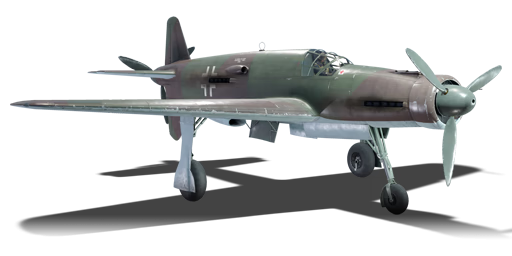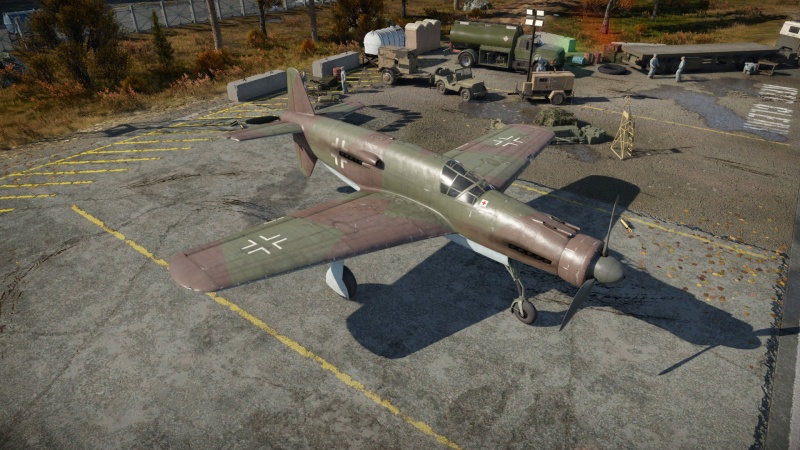Do 335 A-0
| This page is about the German twin-engine fighter Do 335 A-0. For other versions, see Do 335 (Family). |
Contents
Description
The Do 335 A-0 is a rank III German twin-engine fighter with a battle rating of 4.3 (AB), 4.7 (RB), and 5.0 (SB). It was introduced in Update 1.57 "Battle March". This pre-production run does not feature payload options, unlike the A-1 series. Fortunately, this difference is favourable for the A-0 as it features superior aerodynamics and henceforth better top speed, despite only running on the 50PS weaker DB603A (PS = metric horsepower).
Contrary to popular belief, the Do 335 "Pfeil" is not a "super prop". The initial design was a "Schnellbomber" (speedy bomber), but with the start of the emergency fighter program, most bomber contracts were shelved to increase fighter production. At Dornier, the idea arose to reconfigure the current bomber design into a heavy fighter to exploit the failure of Focke Wulf's Ta 154 "Moskito".
Consequently, flight agility is mediocre, lending itself in feeling to Dornier's previous heavy fighters: Do 17 Z-7 and Do 217N, both of which were also originally designed as bombers. The exception to this trait is the fantastic roll rate, accomplished by boosted ailerons as seen on the Ta 152 H-1.
General info
Flight performance
| Characteristics | Max Speed (km/h at 8,400 m) |
Max altitude (metres) |
Turn time (seconds) |
Rate of climb (metres/second) |
Take-off run (metres) | |||
|---|---|---|---|---|---|---|---|---|
| AB | RB | AB | RB | AB | RB | |||
| Stock | 746 | 727 | 11400 | 28.3 | 29.3 | 8.2 | 8.2 | 500 |
| Upgraded | 805 | 775 | 25.8 | 27.0 | 16.4 | 11.8 | ||
Details
| Features | ||||
|---|---|---|---|---|
| Combat flaps | Take-off flaps | Landing flaps | Air brakes | Arrestor gear |
| X | ✓ | ✓ | X | X |
| Limits | ||||||
|---|---|---|---|---|---|---|
| Wings (km/h) | Gear (km/h) | Flaps (km/h) | Max Static G | |||
| Combat | Take-off | Landing | + | - | ||
| 945 | 285 | N/A | 340 | 280 | ~9 | ~4 |
| Optimal velocities (km/h) | |||
|---|---|---|---|
| Ailerons | Rudder | Elevators | Radiator |
| < 380 | < 340 | < 360 | > 350 |
| Compressor (RB/SB) | ||
|---|---|---|
| Setting 1 | ||
| Optimal altitude | 100% Engine power | WEP Engine power |
| 7,070 m | 1,440 hp | 1,642 hp |
| Setting 2 | ||
| Optimal altitude | 100% Engine power | WEP Engine power |
| 8,300 m | 1,430 hp | 1,630 hp |
| Setting 3 | ||
| Optimal altitude | 100% Engine power | WEP Engine power |
| 9,200 m | 1,420 hp | 1,619 hp |
Survivability and armour
- 8 mm Steel - fuel tank/pilot seat plate
Modifications and economy
Armaments
Offensive armament
The Do 335 A-0 is armed with:
- 1 x 30 mm MK 103 cannon, nose-mounted (70 rpg)
Suspended armament
The Do 335 A-0 can be outfitted with the following ordnance:
- 2 x 15 mm MG 151 cannons, nose-mounted (200 rpg = 400 total)
- 2 x 20 mm MG 151 cannons, nose-mounted (200 rpg = 400 total)
Usage in battles
Boom & Zoom: While it does not have the capability to turn, accelerate or climb (sustained) quickly as might an energy fighting aircraft, it can be used to make quick, swooping attacks on enemy bombers, and in a limited capacity, fighters. Advantaged by its swift dive acceleration, Boom & Zoom is a viable tactic; however, it should be noted that prolonged engagements with enemy aircraft should be avoided, as energy fighters will quickly deplete its momentum, and turn-fighting aircraft will easily outmanoeuvre this lumbering aircraft. Instead, diving on a target with a lower energy state (it is permissible to engage some slower aircraft in level flight as the 335 can reach speeds well in excess of 450 km/h within seconds of levelling the aircraft out of a climb) and then simply running away and zoom climbing out of range if the target is not killed on the first run is a significant advantage for DO-335 pilots who wish to return home alive. It may take several runs to kill a target, even with the heavy armament possessed by this aircraft, however momentum conservation is a key advantage of the 335, and multiple swooping attack runs disallow slow, "walking" adjustment of fire by bomber turrets, and can deny a turn-fighter an opportunity to attack, and potentially significantly drain them of energy. Targets in a higher energy state (More altitude and/or speed) should not be engaged unless you can ensure that once you have followed through with the attack run, you will be moving fast enough to avoid retaliation by the target.
Made a problematic aircraft to master by its poor manoeuvrability, both anti-bomber operations and ground strafing are a challenging task in this aircraft; however, it does have bomb capacity for 1,000 kg of ordnance and considering its speed, it is moderately capable in the role of a medium or strategic bomber aircraft. Subsequently, the ability to disrupt soft (20 mm) and hard (30 mm) ground targets far away from the initial fighter onslaught does provide some redemption for its poor anti-aircraft capabilities.
The Do 335's design flaws make it particularly inept at chasing other planes. It is nigh-impossible to try to aim while performing a dive since the nose dances around in all directions and provides no stability to the aiming reticle. Indeed, aiming at the enemy while climbing is prone to the same inaccuracy. Trying to roll the wings to enter a quick dive, e.g. to escape an approaching enemy, is more akin to turning a ship than a heavy fighter. During ground attacks, its inability to aim properly makes more of a "spray and pray" than an accurate firing platform. The most useful approach would be to dive on bombers and attempt to hit with the 30 mm cannon at a distance.
Counter-Tactics
The Do 335 is fast in a dive but flies like a brick. Out-turning it is easy in almost all aircraft it will face. Due to the centre-mounted cannons, it is best to avoid head-ons.
Manual Engine Control
| MEC elements | ||||||
|---|---|---|---|---|---|---|
| Mixer | Pitch | Radiator | Supercharger | Turbocharger | ||
| Oil | Water | Type | ||||
| Not controllable | Controllable Auto control available |
Not controllable Not auto controlled |
Controllable Auto control available |
Combined | Not controllable 3 gears |
Not controllable |
Pros and cons
Pros:
- Excellent top speed at very high altitudes, better than the Me 410 B-6/R3
- Very fast in a level flight
- Great nose-mounted armament
- Great dive top speed
- Great energy retention
- Great roll rate
- Faster than the Me 410 B-6/R3 which fulfils the same role
- Can fly low to hunt tanks and light pillboxes when the MK 103 is equipped with the HVAP rounds
- Can fly with one engine
- Works incredibly well with MEC (Manual Engine Control)
Cons:
- Compared to the Me 410 B-6/R3 it has fewer cannons, no armour, and it lacks defensive turret
- Horrible turn time (can barely out turn a fully upgraded B-25 J-1)
- Below average top speed at sea level compared to other twin-engine fighters
- Is a flying brick due to its size
- Expensive repair cost
- No combat flaps
- Below average climb rate
- Poor durability
- Landing gear takes a long time to deploy and retract
- The nose tends to move when turning
- Bars in cockpits hinders visibility
- Cockpit lacks rear visibility
- Take offs without care can damage the lower rudder
- Engines at both at front and rear of the center axis of the aircraft results in virtually an attack from any angle is bound to hit an engine, and thus impairing engine performance
- Sharp turns with mouse control will cause the elevator and rudder to over-steer, effectively making the plane less manoeuvrable as a gun solution won't become immediately apparent.
- Prone to fires due to 2 engines
History
Redeveloped as a multi-role fighter in late 1942 after the original design as a bomber was cancelled, the Do 335 Pfeil carried a pair of the largest piston engines Germany created during WWII, the DB603 series of inverted V12. The inline design was intended to give dual-engine power but without the parasitic drag that the usual wing-mounted arrangement suffered. By May of 1944, the Do 335 was recognized as such a superior aircraft, with good handling and unmatched speed, that Hitler ordered maximum priority to be given to its production. But Allied bombing campaigns forced Dornier to bring up a new plant to handle production, and the delay meant less than 30 of the aircraft were built and flown before the end of the war.
Only one Do 335 survives today: an A-0 variant, currently on display at the Udvar-Hazy National Air and Space Museum near Dulles Airport in Virginia, USA.
Media
- Skins
- Videos
See also
Links to the articles on the War Thunder Wiki that you think will be useful for the reader, for example:
- reference to the series of the aircraft;
- links to approximate analogues of other nations and research trees.
External links
| Dornier Aircraft Corporation (Dornier Flugzeugwerke) | |
|---|---|
| Fighters | Do 17 Z-7 |
| Do 217 J-1 · Do 217 J-2 · Do 217 N-1 · Do 217 N-2 | |
| Do 335 A-0 · Do 335 A-1 · Do 335 B-2 | |
| Bombers | Do 17 E-1 · Do 17 Z-2 |
| Do 217 E-2 · Do 217 E-4 · Do 217 K-1 · Do 217 M-1 | |
| Jet Aircraft | Alpha Jet A** |
| Helicopters | ◄UH-1D* |
| *Licensed | |
| **Jointly manufactured with Dassault Aviation | |
| Germany twin-engine fighters | |
|---|---|
| Messerschmitt | Bf 109 Z-1 |
| Me 410 A-1/U2 · Me 410 B-1/U2 | |
| Dornier | Do 17 Z-7 · Do 217 J-1 · Do 217 J-2 · Do 217 N-1 · Do 217 N-2 |
| Focke-Wulf | Ta 154 A-1 |
| Junkers | Ju 88 C-6 · Ju 388 J |





